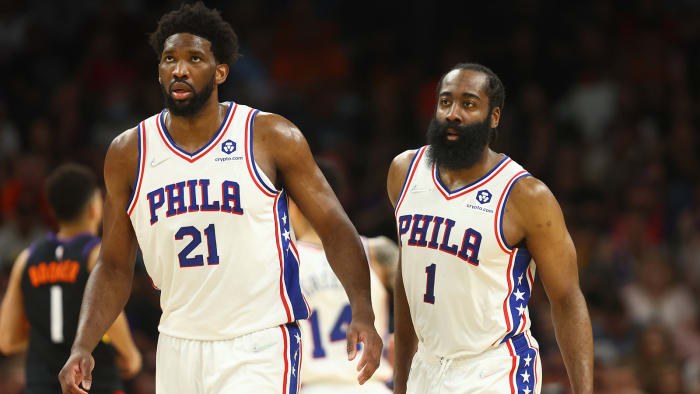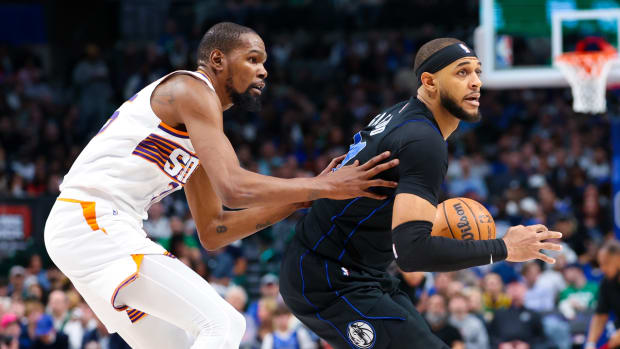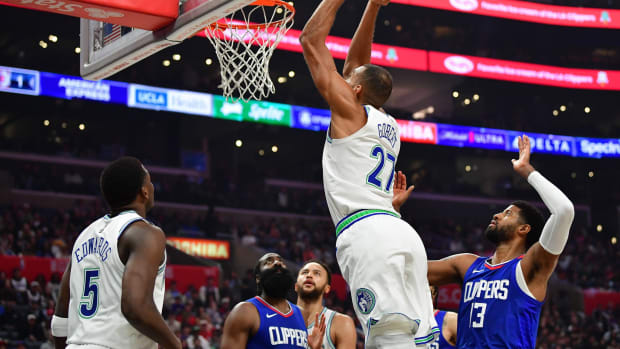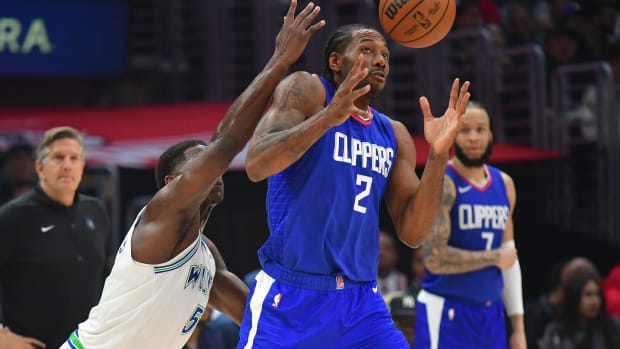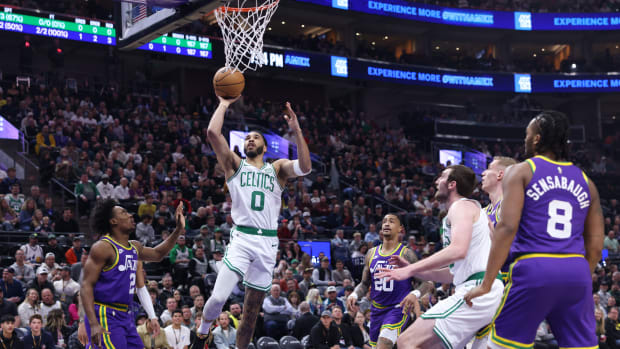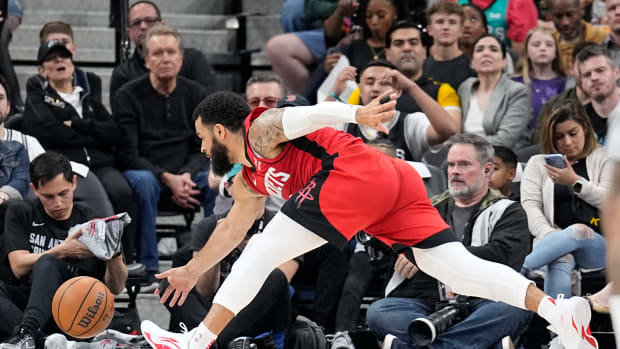Joel Embiid, James Harden and the Sixers’ Rotation Question
The run-up to every postseason tends to spring different anxieties on the Sixers. The most prevalent have typically been linked to a rotation that’s forever scrutinized and rarely ironed out. Most teams encounter a similar dilemma—what is a rotation if not the most advantageous way to organize and exploit a roster’s collective talent?—but Philadelphia’s has, annually, been a source of particular consternation.
In years past, everything revolved around the need to answer a fundamental question: Should Joel Embiid and Ben Simmons be staggered or play a majority of their minutes together?
- Before Philly traded for Jimmy Butler in November 2018, the former was extremely popular. Using input from his analytics staff, Brett Brown aggressively staggered Simmons and Embiid and avoided pretty much ever having fewer than two starters on the court at the same time. Philadelphia’s starting five outscored opponents by a whopping 11.4 points per 100 possessions during a magical 52-win ’17–18 season, but it also accounted for only 25.8% of their total minutes, which ranked 19th in the league.
- The following year they acquired Butler, whose elite pick-and-roll playmaking and aversion to outside shots duplicated some of Simmons’s on-court persona without rectifying enough of his shortcomings. It came to a head during their second-round series against the Raptors, when Embiid and Butler began spending more time in lineups that didn’t include Simmons. (The Sixers were very good when all three played, but their offense went to another level when Simmons wasn’t on the court.)
- Two years ago, during Al Horford and Josh Richardson’s disastrous stint, Brown tried to solve an unfixable dilemma by shifting Simmons from point guard to power forward, moving Horford to the bench and inserting Shake Milton into the starting five. In theory, as Embiid’s backup, Horford could come in and space the floor for Simmons while Joel rested. In reality, Simmons injured his knee and the Sixers were swept by Boston in the first round.
- In Doc Rivers’s first year at the helm, the Sixers embraced a completely different strategy. Instead of staggering Simmons and Embiid, their starting lineup spent more time together than any other in the league, while five-man units that had no starters in them made up 15% of all Philadelphia’s minutes (which was more than any other team). Both groupings helped the Sixers grab the No. 1 seed, and so long as Embiid and Simmons shared the court they were dominant in the playoffs, sporting a +17.74 net rating. The problem was that every other iteration struggled, and Philly was abysmal when both sat at the same time, getting outscored by 9.21 points per 100 possessions in 122 minutes. (These numbers don’t include Game 5 in the first round, which Embiid missed.)
Now, history is (sort of) repeating itself; Embiid and James Harden are a more compatible basketball partnership than Embiid and Simmons, but the same question remains: How do the Sixers get the most out of their star duo?
Should Rivers separate his two Hall of Famers and keep at least one on the floor at all times? Should he extend their playing time together and then brace himself for whatever comes in those non–Harden-Embiid minutes? If split, when should certain members of their supporting cast play? Is Tyrese Maxey maximized (sorry) beside Embiid and without Harden, next to both or by himself?
Sometimes having an unsettled rotation can be perceived as a flex. The Clippers are a perfect example. They can mix and match a dozen players, embrace just about any style of play and take pride in their own unpredictability. It doesn’t matter who starts or who finishes.
This isn’t quite the situation Philadelphia finds itself in. This roster is thin. Behind Embiid, Harden, Maxey and sometimes Tobias Harris, their role players are mostly one-dimensional (i.e., defenders who can’t shoot, shooters who can’t defend and nobody who can put it on the floor and create for others).
Life won’t get any easier over the next couple of weeks, with a starting five that won’t be their normal starting five. Matisse Thybulle chose not to get vaccinated against a highly contagious disease that has killed millions of people and thus is not allowed to enter Canada. After starting every game from January 25 to April 5, Thybulle could not play when the Sixers lost to the Raptors on April 7, and then Rivers chose to start Danny Green instead of Thybulle in the next game, a 13-point win over the Pacers.
In 323 minutes together during the regular season, Harden, Embiid, Maxey, Harris and Thybulle outscored opponents by 20.2 points per 100 possessions, a juggernaut’s number. Their offense and defense were both almost four points better than the league’s best offense (Utah) and best defense (Boston). Thybulle is a 30.7% three-point shooter over the past two seasons, but his ball screens and baseline cuts worked fine enough complementing everybody else. On defense, his duties were a bit more critical.
According to Bball Index, Thybulle spent more time guarding the opponent’s highest-usage offensive weapon than any other defender in the league. (Thybulle’s “matchup difficulty” graded out as 100.0, tying him with Thunder wing Lu Dort.) His value is against opposing starters. Thybulle jumps passing lanes, harasses elite pick-and-roll ballhandlers and, from all the havoc he wreaks on defense, had an extremely positive impact on Philly’s transition offense.
It’s not the largest sample size, but over the 74 minutes Green played with the other four starters instead of Thybulle, Philly’s offense maintained while its defensive rating slipped from 102.1 to 111.0. It’s something to keep an eye on if, for the sake of consistency, Rivers decides to make Green his permanent starting two guard.
Rivers also has to work through an increasingly contentious predicament regarding his backup center, in which the clearest options are DeAndre Jordan (owner of a -13.6 net point differential), Paul Millsap (washed up several months ago), Paul Reed (a 22-year-old who has not played 500 total minutes in his career) and Charles Bassey (a rookie currently dealing with a strained shoulder).
There’s a non-zero chance Philadelphia goes small when Embiid needs to rest (the 6'7" Georges Niang is one choice at the five) and simply hopes to space Toronto out and outscore them for a few minutes. But the Sixers are bad enough on the defensive glass as it is, and the Raptors maul the offensive boards. Small ball may not be tenable in this matchup.
Beyond that relatively minor blemish, though, Rivers has spent the past few weeks tinkering with different lineups, searching for the best ways to amplify his two stars without burning them out. For a few weeks after the trade deadline, Harden and Embiid were staggered quite a bit, with Harden exiting games midway through the first and third quarters so he could check back in a few minutes later, spell Embiid and start the second/fourth quarter leading his own five-man unit.
When it became clear that their biggest advantage was with Harden and Embiid both in at the same time, Rivers stretched Harden’s initial stints in the first and second half, then let him and Embiid rest together. Philly’s net rating with their two best players was +15.9 with an obscene 122.7 offensive rating. Meanwhile, staggering was a disaster, largely thanks to holes in the roster. The Sixers were outscored by 13.96 points per 100 possessions when Embiid played without Harden and outscored by 10.96 points per 100 possessions when Harden played without Embiid.
On March 23, in a five-point win against a Lakers team that didn’t have Anthony Davis or LeBron James, Embiid played all but a couple of his 35 minutes with Harden. The same strategy held two nights later in a blowout win against the Clippers. But a week later, after Rivers used that same rotation in losses against the Suns and Bucks, the hybrid bench/starter units that didn’t include Embiid or Harden were temporarily scrapped, with Harden again playing the second and fourth quarters without Embiid. Clearly, no resolution has been made.
The best option—in my opinion—requires faith in Maxey, a burgeoning Most Improved Player candidate who’s shooting 42.7% from behind the three-point line. So far, his best moments have come as a complementary spark, with only four assists in four games’ worth of playing time without Embiid or Harden. He doesn’t need to be Chris Paul, but if Maxey can keep Philly’s offense afloat as a primary ballhandler in reserve-heavy units it will take some pressure off Embiid and Harden. The positive ripple effects would be huge. (In a small sample size, the Sixers have a positive point differential when Maxey plays without Embiid and Harden.)
The downside with that route is not getting to unleash Maxey as often beside Harden and Embiid, but those two sans the second-year guard have generated a [puts sunglasses on] 140.2 offensive rating, with Shake Milton moonlighting as a tertiary scoring option. It’s all a fascinating puzzle with countless permutations and no one right answer. Some paths are better than others, of course. And with no more time to experiment, it’s on Rivers and his coaching staff to find the best fit before a once-promising Sixers season goes up in flames.
More NBA Coverage:
• NBA Awards: Official Picks for MVP, ROY and More
• Kyrie Irving Has Put the NBA in a Postseason Predicament
• Debating the Most Disappointing Teams






























